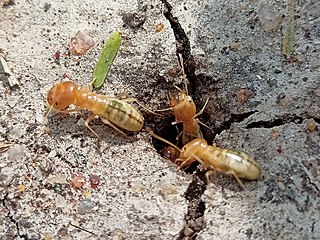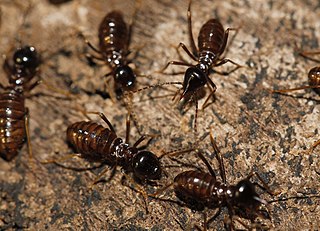The wildlife of Sri Lanka includes its flora and fauna and their natural habitats. Sri Lanka has one of the highest rates of biological endemism.

Anacanthotermes viarum is a species of harvester termite in the family Hodotermitidae. It is found in India and Sri Lanka. It is a grass feeder.
Postelectrotermes militaris, the up-country tea termite, is a species of drywood termite of the genus Postelectrotermes. It is native to India and Sri Lanka. It is a serious pest of tea.
Cryptotermes bengalensis, is a species of dry wood termite of the genus Cryptotermes. It is native to India, Bangladesh, Thailand and introduced to Sri Lanka. It is found in dead and rotten wood of Ficus species. It is a pest of Diospyros insignis.
Cryptotermes ceylonicus, is a species of dry wood termite of the genus Cryptotermes. It is found in Sri Lanka. It is found in living wood, and other man-made wooden constructions. They possess teeth-less mandibles.

The West Indian drywood termite is a species of dry wood termite of the genus Cryptotermes. It is native to Java, Indonesia and exotic to Australia, Trinidad and Tobago and Sri Lanka. It is predominantly a house termite found in natural and man-made wooden structures. Thus, this is the most commonest and most devastating drywood pest termite found in the world. It is a larger termite species, with 4.55–7.15 millimetres length in soldiers.
Coptotermes emersoni, is a species of subterranean termite of the genus Coptotermes. It is native to India, Sri Lanka, and Vietnam. Though it is a wood destroying termite, it was first found from an electrical wire case in the National Museum of Colombo.
Heterotermes ceylonicus is a species of subterranean termite of the family Rhinotermitidae. It is native to India and Sri Lanka. It is a wood destroying termites, which damage to logs, wooden structures of both natural and man-made such as tree stumps of Gravellia and Hevea brasiliensis, and tea plantations. It can be also found in mounds of Hypotermes obscuriceps.
Prorhinotermes flavus is a species of subterranean termite of the genus Prorhinotermes. It is native to India, Sri Lanka, Andaman Islands and Nicobar Islands. It is found in coastal areas such as mangroves. It shows both dampwood and subterranean termite behavior, nesting in dead trees but foraging on soil as a typical subterranean termite. It is not known to be a pest.
Odontotermes globicola is a species of small termite of the genus Odontotermes. It is native to India, Malaysia and Sri Lanka. It is found under flower pots and decaying logs. They construct small chambered nest with spherical combed termitaria.
Speculitermes sinhalensis, is a species of termite of the genus Speculitermes. It is native to India and Sri Lanka. It was first found from Vavuniya. They are typical subterranean soil humus feeding termites, which can be found under logs, decaying trees, rocks.
Nasutitermes horni, is a species of termite of the genus Nasutitermes. It is found in Sri Lanka. It is not considered as a pest, although they are abundant in coconut plantations and forests.
Nasutitermes lacustris, is a species of termite of the genus Nasutitermes. It is found in India and Sri Lanka. This species builds nests on branches of forest trees and can be found in stems of trees like Anacardium, Hevea and Elaeocarpus.

Hospitalitermes monoceros, is a species of nasute termite of the genus Hospitalitermes. It was originally considered to be endemic to Sri Lanka, but was also found in India in 2013. It is an obligate lichen feeder. It is recorded from Cassia multijuga and Ficus religiosa trees and is a pest of tea.
Microcerotermes bugnioni, is a species of small termite of the genus Microcerotermes. It is found from Seenigoda Estate of Sri Lanka. It can be found under logs and in hollow stems of coconut palms.
Microcerotermes cylindriceps, is a species of small termite of the genus Microcerotermes. It is found from Pankulum area of Sri Lanka.
Microcerotermes minor, is a species of small termite of the genus Microcerotermes. It is found from Maha Iluppalama area of Sri Lanka.

Angulitermes ceylonicus, is a species of small termite of the genus Angulitermes. It is found from Maha Iluppalama area of Sri Lanka. Angulitermes ceylonicus has also been found from Nagoda, Kandana of Sri Lanka.



